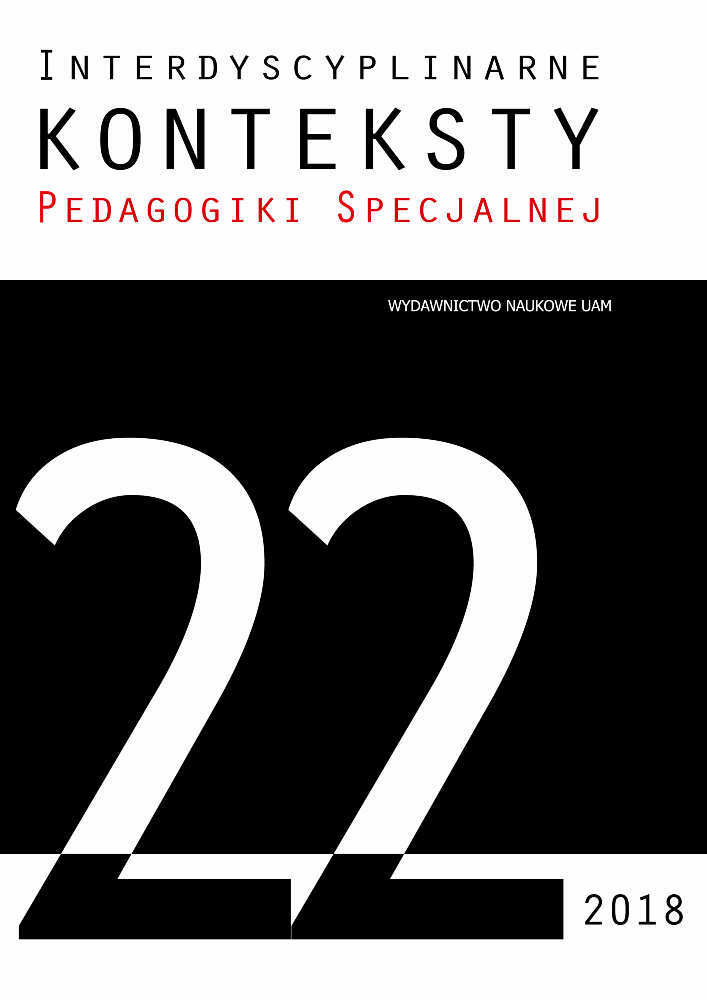Abstrakt
Magdalena Charbicka, Zabawa dzieci z autyzmem w oddziaływaniach terapeutycznych – instrumentalna czy autoteliczna? [Play in autistic children in therapeuticwards – instrumental or autotelic?]. Interdyscyplinarne Konteksty PedagogikiSpecjalnej, nr 22, Poznań 2018. Pp. 105-125. Adam Mickiewicz University Press. ISSN 2300-391X. DOI: https://doi.org/10.14746/ikps.2018.22.06
Play is a typical and natural activity in children, which introduces it to the real world. It plays an uncommonly important function, thanks to the which the little person learns and gains information about their environment, the properties of objects, social relations or other rules. This area is different in children with autism. In most cases, play is accompanied by significant deficits, and the burden of focus of revalidation influences remains on the development of areas that are more disturbed, such as communication, disturbances in social interactions or behaviour hindering functioning. In course of therapeutic work, we sometimes forget the seemingly trivial activity that the playing of a child may be in view of adults. Considering this, it is worthwhile to take a look at the role ascribe to play by specialists over the years, and what it looks like in autistic children.
Bibliografia
Begeer S., Gevers C., Clifford P. and oth., Theory of Mind Training in Children with Autism: A Randomized Controlled Trial, “Joaurnal of Autism Developmental Disorders” 2011, Aug, 41(8).
ASD Prevalence Study across Europe, http://asdeu.eu/wp-content/uploads/2016/09/Poster-ASDEU-Prevalence_AE-Congress.pdf [dostęp: 16.05.2018].
Ball J., Autyzm a wczesna interwencja. Rzeczowe pytania, życiowe odpowiedzi, Wydawnictwo Harmonia Universalis, Gdańsk 2016.
Bryńska A., Jagielska G. Komender J., Autyzm i zespół Aspergera, Wydawnictwo Lekarskie PZWL, Warszawa 2009.
Cieszyńska J. Korendo M., Wczesna interwencja terapeutyczna. Stymulacja rozwoju dziecka. Od noworodka da 6 roku życia, Wydawnictwo Edukacyjne, Kraków 2014.
Charbicka M., Integracja sensoryczna przez cały rok, Difin, Warszawa 2017.
Charbicka M., Dziecko z zespołem Aspergera, Difin, Warszawa 2015.
Chojnicka I., Polska wersja narzędzia obserwacyjnego do diagnozowania autyzmu ADOS, „Psychiatria Polska” 2012, tom XLVI, numer 5.
Community Report from the Autism and Developmental Disabilities Monitoring (ADDM) Network, https://www.cdc.gov/ncbddd/autism/addm-community-report/documents/addm-community-report-2018-h.pdf [dostęp: 12.05.2018].
Filipiak E., Nauczanie rozwijające we wczesnej edukacji według Lwa S. Wygotskiego. Od teorii do zmiany w praktyce, Akademia Centrum kreatywności, Bydgoszcz 2015.
Funded by the Centers for Disease Control and Prevention (CDC), United States Department of Health and Human Services, https://www.cdc.gov [dostęp: 16.05.2018].
Knapp J., Turnbull C., Kompletny program terapii SAZ dla osób z zaburzeniami ze spektrum autyzmu w wieku rozwojowym od 1 roku do 4 lat. Podręcznik terapeuty, Wydawnictwo Harmonia Universalis, Gdańsk 2017.
Lantz, J., Play time: An examination of play intervention strategies for children with autism spectrum disorders, “The Reporter” 2001, 6(3).
Moor J., Śmiech, zabawa i nauka z dziećmi o profilu autystycznym, Wydawnictwo Cyklady, Łódź – Warszawa 2016.
Pisula E., Chojnicka I., ADOS-2 Protokół do diagnozowania zaburzeń ze spektrum autyzmu. Polish edition, Wydawnictwo Mała Litera, Wydawnictwo Cyklady, Hogrefe WPS, USA 2017
Pisula E., Małe dziecko z autyzmem, Diagnoza i terapia, GWP, Gdańsk 2005.
Pisula E., Narzędzia przesiewowe pomocne w rozpoznawaniu ryzyka autyzmu u dzieci w wieku do trzech lat, “Konteksty Pedagogiczne” 2013, nr 1.
Przetacznikowa M., Spionek H., Zabawa jako typowa forma działalności małego dziecka [w:] Psychologia rozwojowa dzieci i młodzieży, red. M. Żebrowskiej, PWN, Warszawa 1982
Rynkiewicz A., Kulik M., Wystandaryzowane, interaktywne narzędzia do diagnozy zaburzeń ze spektrum autyzmu a nowe kryteria diagnostyczne DSM-5, „Psychiatria” 2013, tom 10, nr 2.
SIO https://cie.men.gov.pl/sio-strona-glowna/dane-statystyczne/niepelnosprawnosci-dane-statystyczne/ [dostęp: 16.05.2018].
